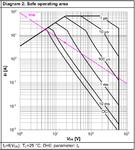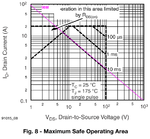asrock70
Full Member level 4
Search engine for transistors / transiotor comparator?
I need to find a MOSFET transistor according to its switching speed and other parameters
Or need equivalent MOSFET, again with an emphasis on switching speed.
There is something like that?
What I'm looking for
Type of Transistor: MOSFET
Type of Control Channel: N -Channel
Maximum Power Dissipation (Pd): 170 W min
Maximum Drain-Source Voltage |Vds|: 400 V min
Maximum Gate-Threshold Voltage |Vgs(th)|: 5.5 V
Maximum Drain Current |Id|: 9 A min
Maximum Drain-Source On-State Resistance (Rds): 0.45 Ohm max
Ciss max 1920pF
td(on) max 11ns
tr max 14ns
Qg(on) max 60nF
After one hour of searching I found only one IXFH12N50F , but price in unacceptable
I need to find a MOSFET transistor according to its switching speed and other parameters
Or need equivalent MOSFET, again with an emphasis on switching speed.
There is something like that?
What I'm looking for
Type of Transistor: MOSFET
Type of Control Channel: N -Channel
Maximum Power Dissipation (Pd): 170 W min
Maximum Drain-Source Voltage |Vds|: 400 V min
Maximum Gate-Threshold Voltage |Vgs(th)|: 5.5 V
Maximum Drain Current |Id|: 9 A min
Maximum Drain-Source On-State Resistance (Rds): 0.45 Ohm max
Ciss max 1920pF
td(on) max 11ns
tr max 14ns
Qg(on) max 60nF
After one hour of searching I found only one IXFH12N50F , but price in unacceptable

